Waning Practicalities: A locavore in the hunger gap
What I ate for a week as a non-food blogger and normal human
Hello High Desert land dwellers and eaters. I wanted to give you an example of what a farmer, preserver, locavore, whole-foods eater, home cook makes and eats in a week. I am hoping this gives you inspiration to be imperfect, to utilize and embrace leftovers, to do a little bit of food prep, and to be ok with the ugly-but-tasty.
*Note- these meals are actually from about two weeks ago, but I am just now getting to write this post (sorry!). I think they still will be helpful for the season we are in though. One thing to note though, is locally grown greens are now available! So, definitely make sure to add a salad to every meal. Also, my apologies, some of the words got cut off in gallery view. If you click to expand the photo, you should be able to read the whole description.

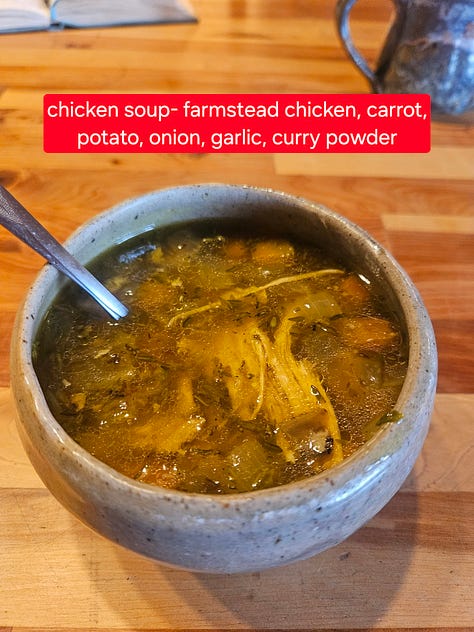

Day 1- On this morning, I finished making an enormous pot of chicken soup. I stuck a whole chicken in the instant pot for about 2 hours pressure cooked, pulled it from the broth, stripped the bones out, put the meat back in the broth, and added vegetables and curry powder. You’ll notice that we eat this over and over again this week.
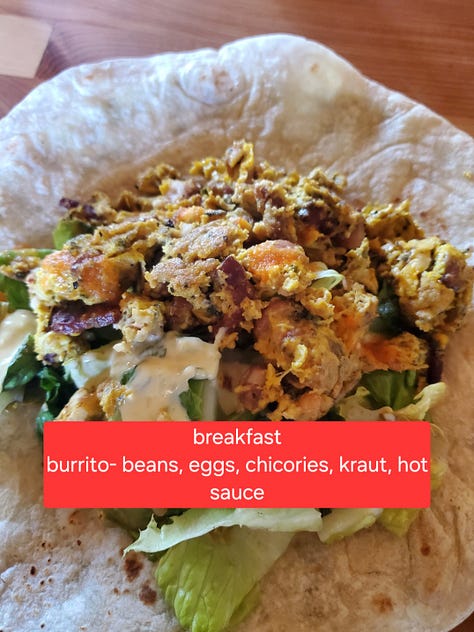


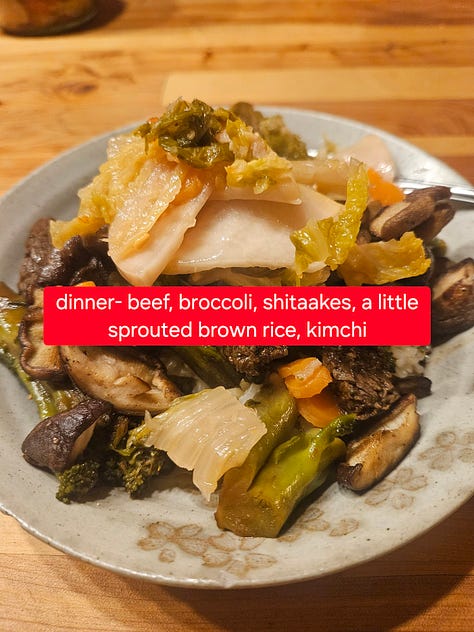
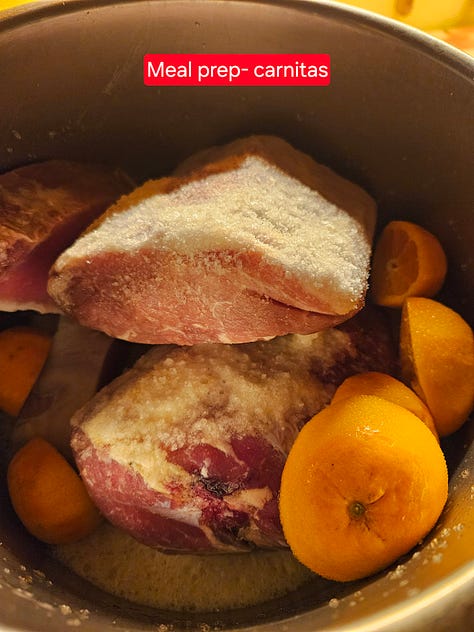
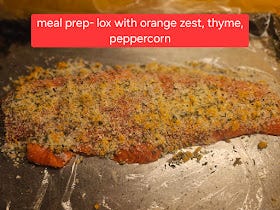
Day 2- We predominantly eat local meat except for one instance- fish. We love buying Wild Coho Salmon from the Fish Princess when she comes into town or at Fill Your Pantry. I also buy the Patagonia Provisions mackerel, sardines, and anchovies, as these small oily fish are very sustainable and full of good fats, vitamins, and minerals. They make an easy protein source.
This day, I also meal prepped two things- Lox and Carnitas (the carnitas will be used in the following *giant* meal prep day).
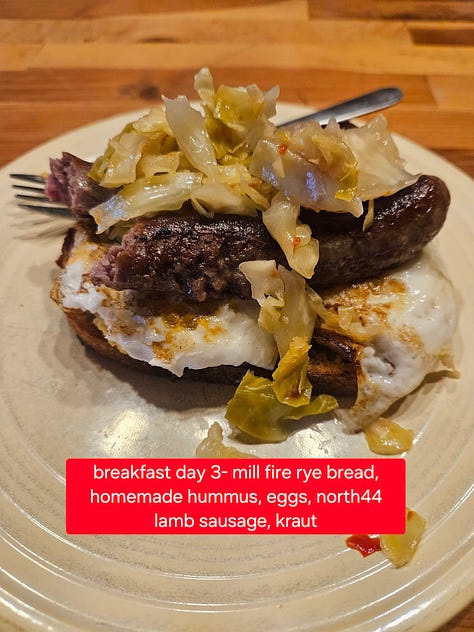
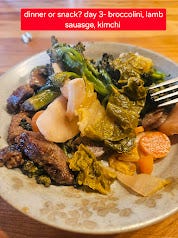
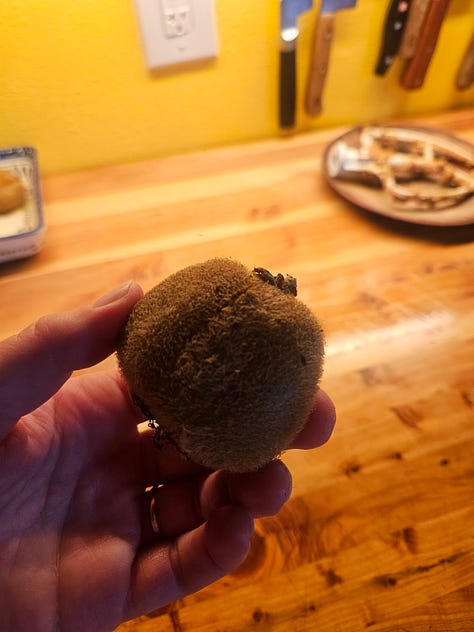
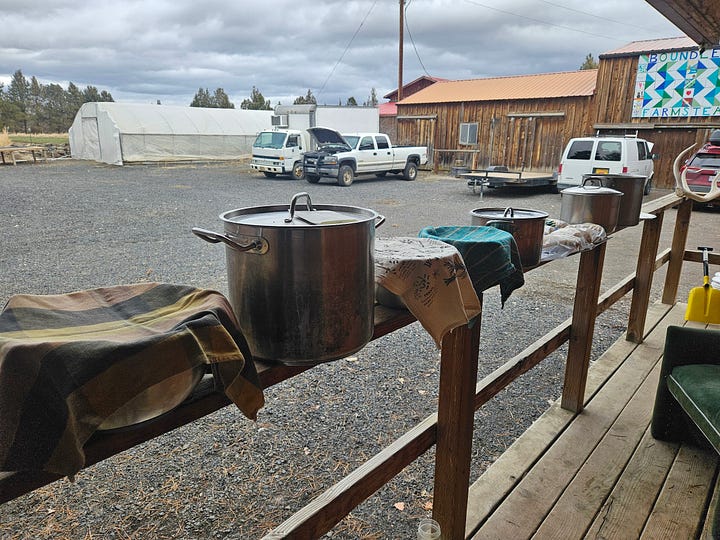

Day 3 was full of so much cooking and disjointed meal eating. For the second year, a group of farmer women has gotten together to make and freeze meals to feed our future, frazzled, sunbaked farmer selves. To ensure that we eat nourishing meals even when we are most busy. We individually prepped fillings for tamales, burritos, and empanadas, then we all came together to swap fillings and assemble the goods. I also made a side of “Megan’s Everything Cookies.” I’ll make a separate post about our food prep extravaganza.
This video shows all of our food prep- the majority of ingredients grown right here on the farm or in Central Oregon. The vats of food in order- Veggie Medley for burritos (all veg from Boundless- storage cabbage, frozen corn, frozen roasted peppers, delicata, onion), Organic White Rice (Lundberg Farms, CA), empanada dough using Rainshadow Organics flour and eggs from our hens, Organic Sprouted Brown Rice (Lundberg Farm, CA), Masa (OG Bob’s Redmill) with Lard (rendered from Steady Home Farm pig fat) and with Avocado Oil (for our vegetarian friend), Carnitas empanada filling (Carnitas from Steady Home Farm pork shoulders, homemade and frozen chimichurri, red onion, and OG sweet potatoes (purchased from store), and Veg Tamale Filling (all grown on farm- beans, squash, peppers, onion, and spinach).

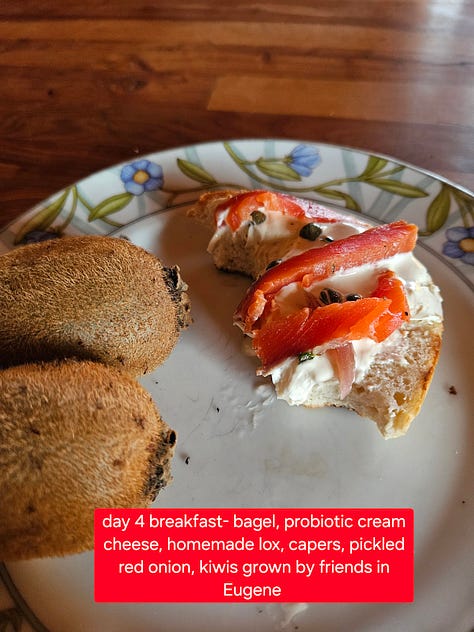
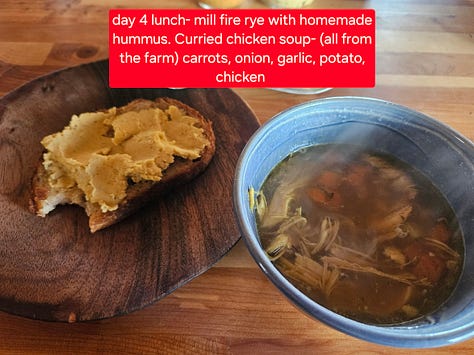
Day 4 was our huge meal assembly day so I didn’t get many photos or really eat a solid meal. Rest assured, I was not hungry. I have also begun a seasonal Amaro making endeavor, which I will do a separate post on as well.
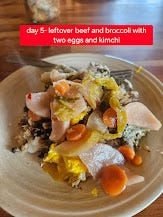

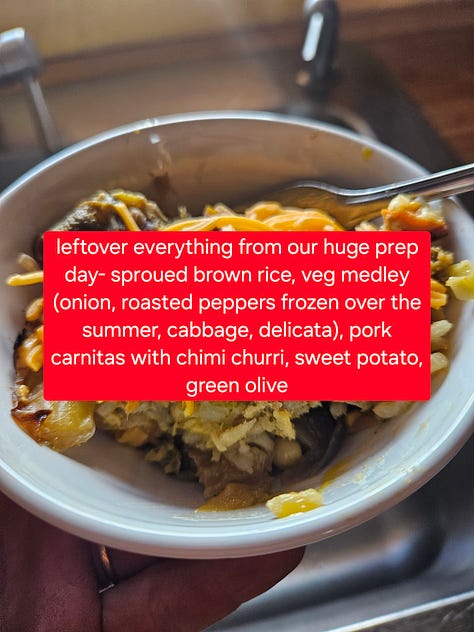
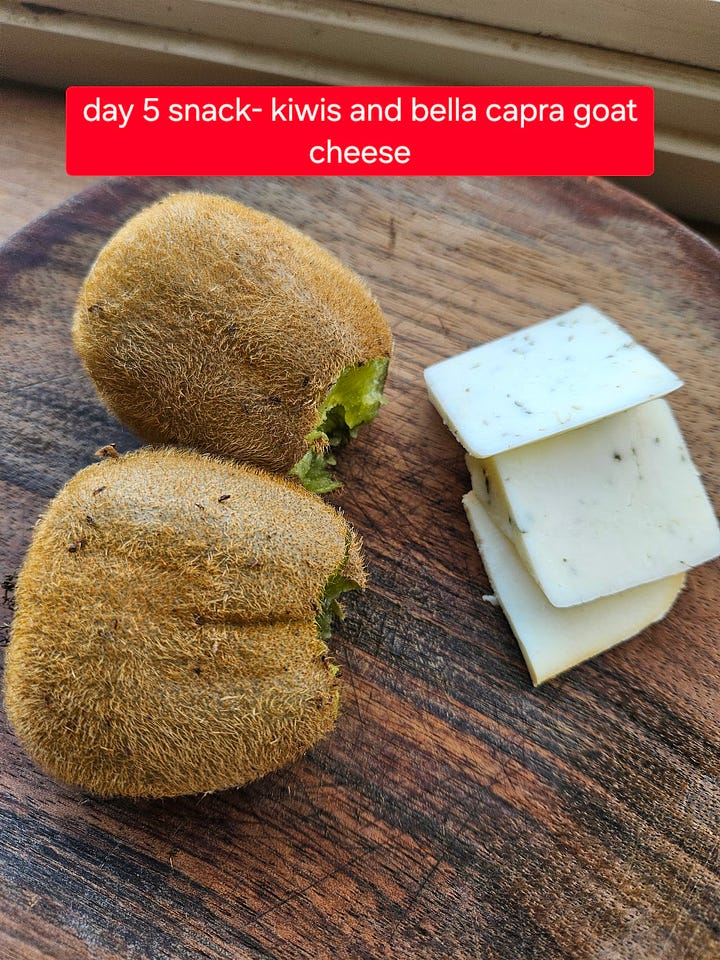
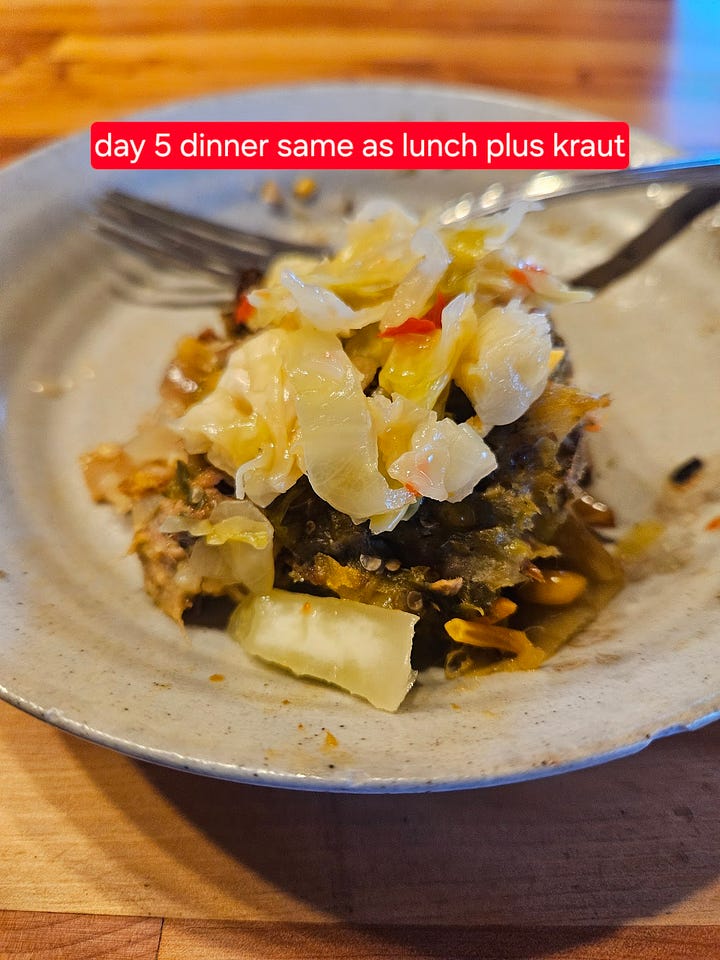
There are a couple of themes developing here- eating lots of leftovers! This is key for me to make sure I have nourishing food, good protein sources, and can keep eating locally. The second theme is fermented foods! I’m not sure if you’ve noticed, but I am a fiend for sauerkraut and kimchi and put it on almost everything I eat. David and I make huge batches throughout the season; it is absolutely a staple in our diet.
Oh, and the kiwis! Our very dear friends Little Wings farm in Eugene, OR have a large kiwi planting and traded us 10lbs of kiwis for the equivalent price in meat (some venison and some pork) when we last visited. I have been gorging on them ever since.


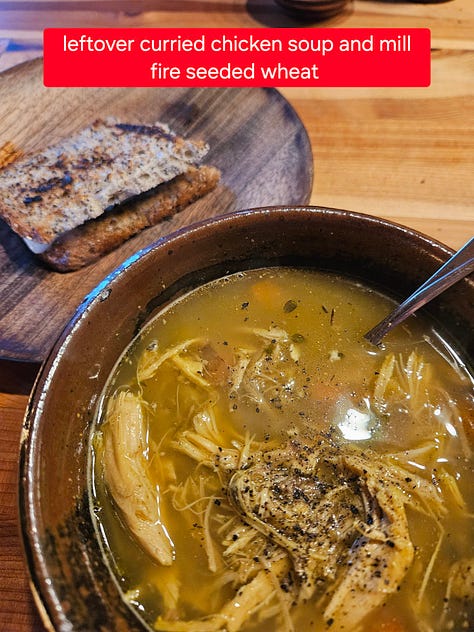
Day 6- My other favorite easy protein sources are North 44 Lamb Sausages. They defrost quickly and it is so easy to make any meal around them.
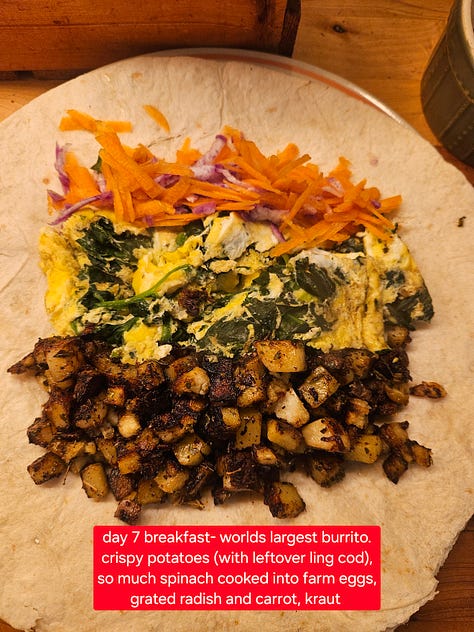
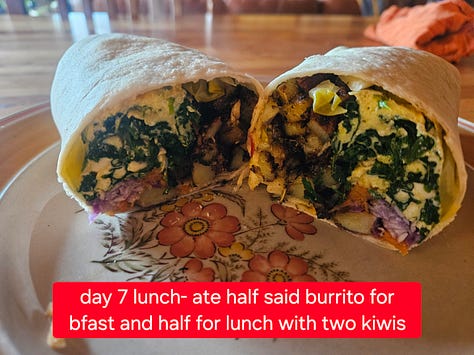
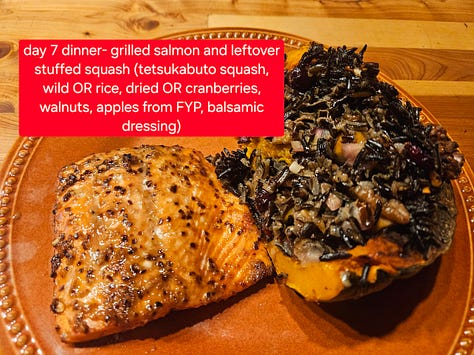
Day 7 (is actually Day 8. As I forgot to take most photos on Day 7 and we went to dinner at a friend’s house that evening). I made the world’s largest breakfast burrito, so it satisfied two meals for me. Dinner was leftover stuffed squash that we had taken to our friends for dinner the night before.
For us, we find that accessing protein and vegetables locally is very easy. All land-dwelling protein we eat is from the High Desert; much of our protein diet this week was wild game that David hunts (venison, chuckar, turkey, and elk), but we also buy pork, beef, and lamb from our farmer friends. We raise our own chicken, eggs, and turkeys. We also grow a large patch of drying beans, typically enough for us to eat for the year. We purchase raw milk from Hope Springs Dairy just down the street from us.
Vegetables are obviously an easy one for us, but we also put a lot of effort into preserving them during the season so that we have access to local vegetables all winter long. We freeze tons of roasted peppers, broccoli, cauliflower, spinach, pesto, chimichurri, and corn. Ferment pickles, kraut, and kimchi. Pickle peppers, asparagus, and cauliflower. And we try to keep some greens alive in our greenhouse all winter including kale, collards, spinach, and chicories. We also have a huge storage of cabbage, carrots, onions, parsnips, potatoes, winter squash, and daikon. Which we are just now getting low on as the first spring crops are starting to come on. We have also started growing, drying, and milling our own cornmeal.
Some things we typically buy that are NOT local- rice, maple syrup, peanut butter and other nut products, coffee and tea, chocolate, oat, some other legumes like lentils and garbanzos, oils (coconut and olive mostly), coconut milk, vinegars, tamari, fish, and occasional grains that we cannot get from Rainshadow. When we buy these things, I first look at Hummingbird Wholesale out of Eugene and try to buy things as local and sustainably-grown as possible (for example, CA-grown olive oil instead of Italy-grown) and buy in bulk. Locavore does a great job of carrying these products as well if you don’t need bulk quantities. I also love the glass jars that I can return.
I wanted to do this post to show that eating locally can be messy, can be repetitive, can be ugly, can be beautiful and colorful, can be a pile of meat and vegetables, can be fast, can be slow, can fit into actual real life. We are some of the busiest people I know, but we have prioritized good food and good health. We make sure to chisel out time each day or week to ensure that we are eating the way we want to be eating.
I know there is privilege associated in all of this, but I want to make some points here- When I was living paycheck to paycheck, I had to cook all of my food at home to make my dollar stretch farther, I gleaned food from farms, I bought simple foods like rice and beans, I gardened, I canned, I preserved, I traded at the farmers market. I still ate a lot of local, whole, home cook foods. Did I eat as much local protein? No, I was mostly vegetarian at that point. Can everyone do this? Probably not, I was in my 20s, with no children, and very inexpensive rent. Do I expect everyone to be able to do this? No, I understand people are all in different circumstances. I am mainly talking to the folks who have the option to cook local food. Not those who are just getting by.
To me, locally grown foods encompass everything that is important- environmental sustainability, local community, food security and sovereignty, healthy living, connection to place, etc. I hope you can find the joy and purpose in local food that I do!
Please post any questions about local eating in the comments. I love helping folks eat more locally and sustainably, learn to cook, and get excited about food.


